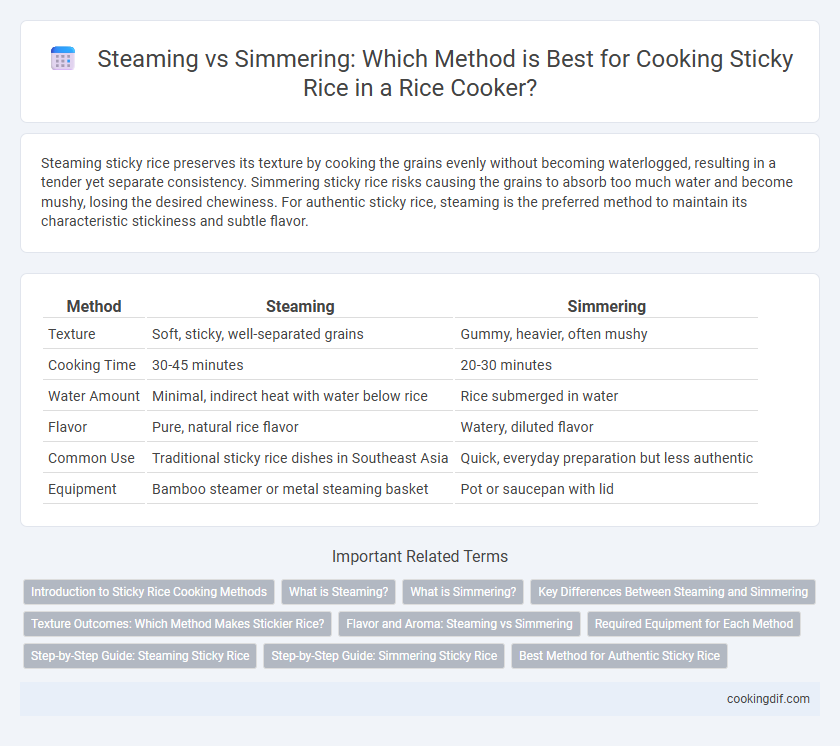Steaming sticky rice preserves its texture by cooking the grains evenly without becoming waterlogged, resulting in a tender yet separate consistency. Simmering sticky rice risks causing the grains to absorb too much water and become mushy, losing the desired chewiness. For authentic sticky rice, steaming is the preferred method to maintain its characteristic stickiness and subtle flavor.
Table of Comparison
| Method | Steaming | Simmering |
|---|---|---|
| Texture | Soft, sticky, well-separated grains | Gummy, heavier, often mushy |
| Cooking Time | 30-45 minutes | 20-30 minutes |
| Water Amount | Minimal, indirect heat with water below rice | Rice submerged in water |
| Flavor | Pure, natural rice flavor | Watery, diluted flavor |
| Common Use | Traditional sticky rice dishes in Southeast Asia | Quick, everyday preparation but less authentic |
| Equipment | Bamboo steamer or metal steaming basket | Pot or saucepan with lid |
Introduction to Sticky Rice Cooking Methods
Steaming and simmering are two primary methods used to cook sticky rice, each affecting texture and flavor differently. Steaming involves cooking rice with indirect heat, preserving grains' stickiness and providing a tender, chewy consistency ideal for traditional sticky rice dishes. Simmering submerges rice in water, often resulting in softer, less cohesive grains, which may be less desirable for authentic sticky rice preparation.
What is Steaming?
Steaming sticky rice involves cooking the rice with indirect heat by placing it above boiling water, allowing the steam to gently cook each grain while maintaining its natural texture and flavor. This method preserves the rice's sticky consistency and prevents it from becoming waterlogged, which is common in boiling or simmering. Steaming is essential for dishes requiring sticky rice with a chewy and cohesive texture, often used in Southeast Asian cuisine.
What is Simmering?
Simmering is a cooking technique where rice is cooked in water just below boiling point, typically around 185degF to 205degF, allowing grains to absorb moisture slowly and evenly. For sticky rice, simmering helps develop its characteristic chewy texture by gently softening the starches without breaking the grains apart. This method requires careful temperature control to prevent overcooking or uneven texture compared to steaming, which uses indirect heat and maintains rice structure more effectively.
Key Differences Between Steaming and Simmering
Steaming sticky rice involves cooking the grains with indirect heat, preserving their texture and preventing waterlogging, resulting in a fluffy yet chewy consistency ideal for traditional dishes. Simmering submerges the rice in water at a low boil, which can cause the grains to absorb excess moisture and become mushy, compromising the desired sticky texture. The key difference lies in moisture control and heat application, with steaming offering precise temperature regulation that maintains the integrity of sticky rice grains.
Texture Outcomes: Which Method Makes Stickier Rice?
Steaming sticky rice yields a chewier and more cohesive texture by evenly cooking the grains without excess water absorption. Simmering risks overhydrating the rice, leading to a softer but less sticky result due to water saturation. For optimal stickiness, traditional steaming is preferred in preparing authentic sticky rice varieties.
Flavor and Aroma: Steaming vs Simmering
Steaming sticky rice preserves its natural nutty aroma and delivers a tender, slightly chewy texture by gently cooking the grains without direct water contact. Simmering tends to dilute the rice's flavor and aroma as the grains soak and absorb excess water, resulting in a softer, less fragrant dish. For authentic sticky rice with enhanced flavor brightness, steaming remains the preferred cooking method.
Required Equipment for Each Method
Steaming sticky rice requires a bamboo steamer or a specialized rice basket and a pot with a tight-fitting lid to trap steam effectively. Simmering sticky rice necessitates a heavy-bottomed saucepan with a secure lid to maintain consistent low heat and prevent burning. Both methods benefit from using heatproof containers to ensure even cooking and preserve the desired sticky texture.
Step-by-Step Guide: Steaming Sticky Rice
Steaming sticky rice requires rinsing the rice until the water runs clear, then soaking it for at least 4 hours to achieve the desired texture. After soaking, drain the rice and place it in a bamboo steamer lined with cheesecloth, steaming over boiling water for 20-30 minutes while occasionally checking for doneness. This method preserves the rice's natural sticky quality and prevents it from becoming mushy, unlike simmering which can lead to a waterlogged texture.
Step-by-Step Guide: Simmering Sticky Rice
Simmering sticky rice involves rinsing the rice thoroughly and soaking it for at least 30 minutes to achieve the ideal texture. Place the soaked rice in a pot with a measured amount of water, typically a 1:1.25 rice-to-water ratio, and cook over low heat without stirring to prevent clumping. Cover the pot tightly, simmer gently for 15-20 minutes, then let it rest off the heat for 10 minutes to allow the grains to finish cooking evenly and develop the perfect sticky consistency.
Best Method for Authentic Sticky Rice
Steaming is the best method for achieving authentic sticky rice, as it preserves the rice's natural texture and prevents excess water absorption that occurs during simmering. This technique maintains the grain's stickiness and ensures even cooking by surrounding the rice with moist heat, rather than submerging it in water. Traditional Southeast Asian recipes favor steaming to retain the distinctive chewiness and flavor essential to sticky rice dishes.
Steaming vs simmering for sticky rice Infographic

 cookingdif.com
cookingdif.com